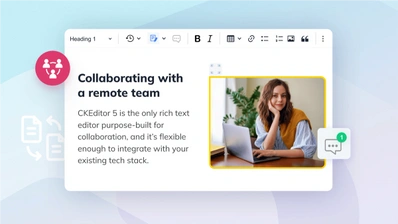How collaborative innovation makes companies more competitive and better

The world is changing very fast. Big will not beat small anymore. It will be the fast beating the slow — Rupert Murdoch
Nokia, Kodak, Xerox, MySpace, IBM, BlackBerry, Hitachi, and Yahoo! — are a few examples of companies that have lost their momentum due to the lack of innovativeness, the inability to apply new business models, resisting changes regarding digital transformation, and protecting what had already been achieved. Their managers might have been so happy with the status quo that they thought doing everything the old way would keep them on the top forever. But the business environment changes, as do social moods and trends. There are, however, examples of entrepreneurs that managed to embrace the new business reality but also chose the right tools to make their strategic transformation successful and complete. One of such highly effective tools is collaboration, preferably real-time collaboration. In this article, I’ll show you how easy, fun, and efficient it is to innovate through collaboration.
# 1. How not to miss a chance for innovation
The entrepreneur always searches for change, responds to it, and exploits it as an opportunity — Peter F. Drucker
These days, resisting changes often means opposing innovations and the opportunity to create a new product, a new initiative, a new ecosystem, or even a new startup. Business executives tend to forget that when the adaptation process is over, the company will be faster, more productive, and effective, and thus, a lot of money will be saved or earned. Also, busy with day-to-day operations, they overlook that there are thousands of competitors out there, who are not afraid to apply changes or adapt to them fast. But if you are scared of change, or simply fail to see the need for it, it won’t disappear, of course, but will probably come and get you anyway.
# Yahoo!’s failure: hesitation and missed opportunities
Brave and farsighted leaders are necessary for corporations to innovate, the issue often brought up when discussing Yahoo!’s case. Due to the lack of clear vision, hesitation, and poor business decisions, the company, dubbed one of the internet pioneers, missed several great opportunities, including to buy Google in 2002 and Facebook in 2006. It didn’t use the newest microblogging and social media trends to its advantage either but experienced a failure with Tumblr and mismanagement of Flickr instead. What added up to their demise were too bureaucratic a company culture and not putting enough emphasis on programming or hiring top-notch developers.
# Kodak’s case: denying social trends
Of course, innovations need to be introduced carefully, with the right timing and following a thorough analysis. If we take Kodak’s example, it’s not that the corporation didn’t do anything on the innovation front. It did quite a lot. For instance, it created a digital camera in 1975 and bought a photo-sharing site in 2001, so in theory, it had a great starting position for the upcoming digital transformation era. Unfortunately, Kodak’s decision-makers lacked the awareness that times were changing lightning fast. As a result, the digital camera ended up as a prototype, and the website, instead of shining bright as a pre-Instagram, was used for printing digital images rather than sharing them online along with other updates.

As we can see, being innovative in technological terms is not enough. We need to be alert and aware of what is happening in society as a whole and try to go with the flow. Consumer and social trends, like real-time applications and business collaboration, are something we should never miss.
# 2. Collaborative effort — a necessary condition for innovation
Collaboration equals innovation
— Michael Dell
When we want innovations to go smooth and fast, we’d better collaborate. Collaboration is what many business executives find a necessary condition for creating innovative tools and solutions. And scholars praise the power of innovation through collaboration, including business collaboration, that is to spark progress in virtually all dimensions. Collaboration accelerates innovation performance — across different companies but most of all across departments within particular businesses.
# Innovations today: a switch from R&D teams to regular employees
Also, as time goes by, we may observe a shift from the traditional model where innovations were accomplished by specialized R&D teams, to a situation where a fruitful collaboration — on-site or remote — between multiple contributors, like regular employees, is at the very center of creating novel solutions.
# Moving towards digital and real-time collaboration
Going online is absolutely crucial for today’s businesses, which are immersed in digital transformation. Switching to digital not only concerns online marketing and sales but also using communication tools that are truly modern and let us enjoy incredible advantages. And this is the case of CKEditor 5, a WYSIWYG rich-text editor offering cutting-edge solutions regarding content creation, including collaborative editing, a hallmark of collaborative innovation. Here, both the result and the user experience when dealing with document collaboration are the best possible. What’s more, using CKEditor’s interface is intuitive and easy, and you may learn it very fast, without painful and stressful training many people fear and hate the most about new technologies.
# Modern communication tools that make a true difference
Indeed, switching to modern tools and novel applications may be difficult. Some people are simply not eager to learn how to do things in new ways, especially if it involves technology, and if they’ve been doing it differently for ages. But we need to understand that the way we communicate and work will never be the same as it had been back in the 1990s or 2000s. And trying to ignore it, we only make things worse for ourselves and for the organizations we run or work for. There are thousands of IT teams out there who struggle to make working people’s lives easier, and it would be unreasonable not to take advantage of it. Of course, the ultimate goal of their efforts is making the client company’s effectiveness, and productivity (and thus the revenue) higher, but the former doesn’t sound bad, either.
# Don’t waste time on exhausting and useless real-world meetings
These objectives may also be achieved thanks to limiting the number of — scheduled and impromptu — meetings that have been put under scrutiny lately. If organized too often and too much, they kill creativity, effectiveness, and innovativeness — qualities they are supposed to encourage if used in a reasonable amount. Business consultants and executives are wondering how to, literally, stop wasting time in meetings, or even stop the meeting madness, and simply avoid collaborative overload.

One of the ways to enhance collaboration without wasting time on engaging everybody in the company is using a powerful WYSIWYG editor such as CKEditor 5 that enables jumping in and collaborating whenever we wish and want to contribute anything, like writing a single figure or a comma, and getting back to our daily duties right away. All of the content is stored in one place, with the possibility to track changes, and comment at any time.
# 3. Outdated processes (and tools) that drag companies down
Some people don't like change, but you need to embrace change if the alternative is disaster — Elon Musk
Changes in organizations have always been there but in recent decades the innovative drive has been as true as never before. We live in the times and the culture of change, underpinning all aspects of our lives, both personal and professional. Over and over, we hear about how beneficial leaving our comfort zone is. Even if we don’t like changes, all we can do is adapt to them, or stay outside and watch others grow and transform. Adapting to new circumstances, and being alert instead of paralyzed with fear is not something that guarantees we will stand out and succeed. It is, however, a necessary condition for businesses to stay in the market, these days.
When we want innovations to go smooth and fast, we’d better collaborate.
# Outdated systems and tools put organizations at risk
One of the ways to adapt to those transformations is through collaborative leadership and real-time collaboration. By using a collaborative rich text editor, we let people at all organizational levels be heard and share their ideas (and doubts and fears, too!) to encourage faster open innovation. This can help our company stay in business, and sometimes even survive. This may also help us with overcoming problems with legacy systems in corporations — outdated systems and tools organizations still use that may limit their expansion or even put their existence at risk.
# Nokia’s case: sticking to the old solutions
And sticking to old solutions is considered to be one of the reasons for Nokia’s failure. The Finnish company, established over 150 years ago, enjoyed great success worldwide back in the 1990s. But when “connecting people” (Nokia’s slogan) turned out not to be enough anymore, clients moved to more alert competitors who managed to trace the change in people’s needs instead of focusing on the status quo.
# Aversion, hesitation, and organizational fear
The high-profile Finnish corporation was to reject hundreds of potential innovations in the 2000s, and decline to entirely rewrite Symbian’s code. Of course, Nokia became one of the victims (along with BlackBerry) of the touchscreen smartphone revolution that began around 2010. But it was the aversion, hesitation, and organizational fear that contributed to the disaster.

# Staying focused, alert, and not ignoring the signs
Nokia’s failure may serve as a warning for all businesses, no matter the size or industry. When the company’s purchase by Microsoft was announced, Nokia’s CEO, Stephen Elop, stated that “We didn’t do anything wrong, but somehow, we lost”. But “not doing anything wrong” very often means just standing still, while the others around us are in a hasty race for success. There are always dynamic young guns out there who’d love to put us out of business, and they will do anything to achieve this goal. To survive, we just need to stay focused, and alert, especially regarding the use of things like social media, and modern tools increasing efficiency in the workplace, like CKEditor 5.
# CKEditor 5 — a modern tool increasing workplace efficiency
Utilizing it may tip the scales and decide whether we stay afloat or dip deep under. First of all, the feature-rich CKEditor 5 lets us handle all our content creation tasks much faster. We have everything it takes in a single editor, no need to copy-paste from external sources or tools. Also, the quality of the work tends to be higher, as real-time collaborative editing produces greater results since everyone is encouraged to cooperate and contribute.
# 4. How much you can gain by embracing the new, and how you can do it
All things are difficult before they are easy
— Thomas Fuller
Sticking to something well-known but not that efficient may be detrimental to the company. Getting out of legacy systems and introducing business process optimization are certainly worth trying. We may be afraid of the workload implementing these changes entails but after the job has been done there’s a brand new world of opportunities at our feet. And that’s the case of CKEditor 5 and the real-time collaboration it brings to organizations at all levels. There are thousands of innovative companies out there that use CKEditor 5 to their greatest advantage, expanding businesses and boosting productivity.
We need to understand that the way we communicate and work will never be the same as it had been back in the 1990s or 2000s.
# Spotlight’s and Tablo’s success stories
One of them is Spotlight Analyst Relations. Its Managing Partner, Rick Nash, points out that “real-time collaboration is the key differentiator for CKEditor 5 against its competitors”. The company successfully switched from stressful and time-consuming content aligning from different sources such as Excel, Word, Asana, and Evernote to a modern tool with a strong CKEditor 5 in the heart of it to capture everything at once. This is certainly a good way to follow if your company is growing fast and you don’t want your staff to get stuck on things like resolution delays and simply miss the chance for something big. Alex Eckermann, CTO at Tablo, confirms that "CKEditor 5 has set us up for the future. We are no longer held back in the past, in a world of old web browsers”.
# CKSource: moving from one innovation hit to another
But there’s also a space for embracing new possibilities and experimenting within the existing companies, as was the case of CKSource. Although CKEditor 4 was a major success, the entity behind it, CKSource, decided to develop CKEditor 5 differently, rewriting the code from scratch. This also turned out to be a huge success and thousands of users received a stable and robust editor of tomorrow they can take advantage of today. Of course, if they are not afraid to grasp the chance, too.
But, in the very beginning, it was a matter of innovations, too. The challenge the company had to take up in the first half of the 2000s was to create a modern, complex and reliable rich text editor that would run well in web browsers, as there were no products like that in the market at that point. CKSource Founder, Frederico Knabben, was a programming pioneer that went the whole way from desktop to web applications, and it was an early CMS where he found out that there was no quality editor available to use within it and decided to create one on his own.
# CKEditor 5: innovative features way ahead of the competition
If we’re ready to reach out to the new and the unknown, we may end up just like Sean Linehan, CEO ofPlacement, with a self-reliant solution that helps create a better offer for clients, and satisfied users that enjoy the integrated nature of the platform enhanced with collaboration features a lot. This way, we may simply get a position that is way ahead of competitors.
What’s more, not only does CKEditor 5 solve current problems but also creates great prospects for business development and further expansion, just like it was in the case of Agreemint. Its CEO and Founder, Peter Graham, also stresses the customer-focused implementation process and the importance of the outstanding CKEditor 5 customer support that, by directly addressing bugs in its functionalities, enables keeping clients’ staff smaller and more focused on business-related issues.
If you want to join those progressive companies and see for yourself how collaborative editing triggers innovation try our real-time collaboration demo or contact us now!
You can read more on the topic of collaboration in our blog posts:
- Real-time collaboration - 7 greatest benefits - CKEditor 5
- Tackle too many unproductive meetings - CKEditor 5
- Healthcare SaaS: How innovative software solutions are transforming the medical industry
- Best practices of remote work are at CKSource - Come join us!
- Content collaboration best practices in a nutshell - CKEditor 5
- Remote collaboration - Software that improves working from home - CKEditor 5
- Collaborative writing and how to implement it in your application
- Document collaboration tools - how to break down barriers to success


